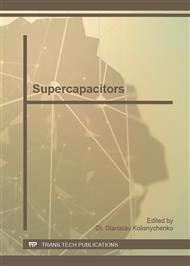p.1189
p.1193
p.1197
p.1201
p.1205
p.1210
p.1214
p.1218
p.1222
Capacitance Fading Induced by Degradation of Polyaniline: Cyclic Voltammetry and SEM Study
Abstract:
Polyaniline (PANI), one of the most studied conducting polymers (CPs), shows great promising application in supercapacitor in advanced power system. In present work, the capacitance fading of PANI nanofibers modified stainless steel (PANI/SS) electrode was investigated by combination of cyclic voltammetry (CV) and scanning electron microscopy (SEM). The kinetics of capacitance fading can be fitted to a second-order exponential decay. The fading rate constant of the capacitors increases by two orders magnitude when the upper-limit potential in CV increases from 0.55 to 0.80 V vs. SCE. We proposed that there are three factors leading to the capacitance fading, the first one is the hydrolysis of quinoid units in PANI produced during electrodeposition process or/and high potential applied, the second one is chemical degradation of PANI induced by the attack of solvated anions on nitrogen radical cation, and the third one is the electrochemical degradation of PANI which is due to the benzene radical cation. Additionally, the SEM images show that the morphology of newly formed PANI nanofibers are in gel structure, and become clear with the gel structure disappeared after 1000 cycles. Moreover, some regular particles appear at the electrode surface, which are supposed to be produced from the accumulation of the degradation product.
Info:
Periodical:
Pages:
1205-1209
Citation:
Online since:
June 2012
Authors:
Keywords:
Price:
Сopyright:
© 2012 Trans Tech Publications Ltd. All Rights Reserved
Share:
Citation:



